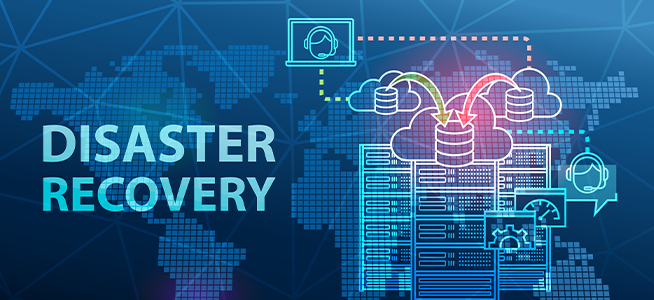灾难恢复的例子有哪些?
本杰明•富兰克林 once said, “by failing to prepare, you are preparing to fail.” When it comes to 灾难恢复 for businesses, this sentiment certainly rings true. 事实上,根据 柴郡消防, about 75% of companies worldwide who do not have a 灾难恢复 plan in place fail within 3 years of disasters occurring. 这就是为什么在这里 MG游戏登录网页, we take 灾难恢复 and business continuity planning seriously as a part of our IT infrastructure services.
There is certainly a lot to consider in regards to the 灾难恢复 process. To help simplify it a bit, we are taking a look at:
灾难恢复的类型和示例
灾难恢复计划阶段
How Moser can help you be better prepared
灾难恢复有哪些类型?
There are three types of 灾难恢复 based on and named after the three types of disasters: technology-based, 物理, 和自然.
基于技术的灾难
顾名思义, technology-based disasters have to do with the IT or cybersecurity of an organization. Examples of technology-based disasters include things like:
勒索软件和恶意软件攻击
意外数据泄露
安全漏洞
网络钓鱼诈骗
服务器故障
数据丢失
网络中断
这样的例子不胜枚举. Because there are so many potential ways 和机会 for technology-based disasters to occur, they are in fact the most frequent of the three types.
A technology-based 灾难恢复 plan should include considerations for the following questions:
What work does the impacted technology support?
What type of IT incident would be the most damaging to your business?
How can you protect against total data loss?
What limitations will this disaster place on your organization? 要多久??
物理灾难
Physical disasters can cover a wide array of events. They could be building-related issues such as a burst pipe or a broken HVAC system. They can also include 物理 break-ins and security breaches. They might also take the form of wider infrastructure failures like a loss of power or running water.
You 物理 灾难恢复 strategies should address:
这将如何影响实物资产, and for how long?
Will your communications or workflow be impacted, and if so, how?
How will you react to a long-term issue?
How will you react to a short-term issue?
What third-parties might you need to rely on to help you?
How can you support your employees' needs throughout the process?
自然灾害
When most people hear the word disaster, this is probably the type they first think of. Natural disasters include things like tornadoes, 火灾, 洪水, 飓风, 以及其他与天气有关的灾难. Other types of natural disasters could include things like a pandemic or even employee deaths or injuries.
A natural 灾难恢复 plan should consider the following questions:
这将如何影响实物资产?
Will your communications methods be affected, and if so, how?
Will your workflow be impacted, and if so, how?
How can you support your employees' needs throughout the process?
什么是3个灾难恢复阶段?
Three phases of 灾难恢复 are preparedness, response, and recovery. Oftentimes, people might include mitigation as the first phase of 灾难恢复. 然而, no matter how much you work to minimize the risk of disaster, there are certain things you can’t control or prevent entirely. That is why it’s important to map out your preparedness, response, and recovery plans.
准备: Preparedness focuses mainly on understanding how a disaster may impact your company and how education and training can help enable your team to respond. This includes creating a business continuity and 灾难恢复 plan, educating employees on emergency protocols, and actively and testing maintaining your 灾难恢复 methods.
Response:在响应期间, your organization addresses the most immediate threats of the disaster. This can include things like safety precautions, 解决基本人道主义需求, 清理, 损失评估, 重建通信, and more depending on the type of disaster.
Recovery: In this phase, the goal is to restore the business to operations. At first the idea is to restore the organization to a sustainable state. Eventually however, the goal will be to resume full-service operations.
随时准备与Moser咨询
At MG游戏登录网页, we know how important it is to be prepared for the worst. But, even if you “expect the unexpected,” how can you be sure you are actually prepared for it? One key way is to put your 灾难恢复 plan to the test. With our table top activities, we do exactly that.
活动期间,mg官方游戏中心:
Get your 灾难恢复 team and key stakeholders in the room together
Present a hypothetical scenario (ransomware, tornado, data leak, etc.)
Simulate the scenario and observe the disaster plan in action
在这一切发生之后, we put together an after action report that summarizes the plans strengths, 弱点, 和机会. We then suggest remedial actions that can help improve your plan. These recommended remediations can be done through Moser, or on your own.
Our end goal isn’t to cast blame or trick you into buying more services from us. We simply want to act as a true partner, 顾问, and extension of your team to make sure that when disaster inevitably strikes, 你准备好了. mg官方游戏中心 今天开始.


